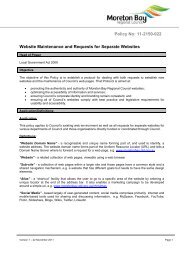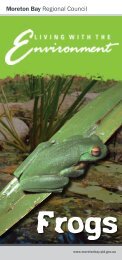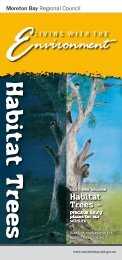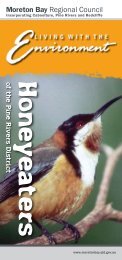Fact sheet Declared class 3 Pest Plant Camphor laurel
Fact sheet Declared class 3 Pest Plant Camphor laurel
Fact sheet Declared class 3 Pest Plant Camphor laurel
Create successful ePaper yourself
Turn your PDF publications into a flip-book with our unique Google optimized e-Paper software.
<strong>Fact</strong> <strong>sheet</strong>DECLARED CLASS 3 PEST PLANT<strong>Camphor</strong> <strong>laurel</strong>Cinnamomum camphora<strong>Camphor</strong> <strong>laurel</strong> was introduced into Australia from Asiain 1822. It has been promoted and planted as a gardenornamental throughout Queensland.<strong>Camphor</strong> <strong>laurel</strong> is an attractive shade tree, but can be verydestructive—it aggressively replaces native vegetation.The long-term consequences of its spread may result inthe loss of native wildlife and agricultural productivity overlarge areas of south-east Queensland.<strong>Camphor</strong> <strong>laurel</strong> invades pastures and disturbed ripariansystems. It tends to germinate under fences and powerlines (wherever birds rest and deposit the seed). As aresult, it can push fences over and disrupt power facilities.It is a troublesome weed on dairy farms throughout southeastQueensland and northern New South Wales.Along the waterways of south-east Queensland, camphor<strong>laurel</strong>s are replacing the native blue gums threateningkoala populations.Old camphor <strong>laurel</strong> trees develop a massive root systemthat can block drains and crack concrete structures.The average suburban backyard is far too small toaccommodate a mature camphor <strong>laurel</strong> without problems.Removal of a mature tree can cost hundreds of dollars.PP46 January 2011
Stem injectionFor trees taller than 6 m, stem injection using a modifiedaxe is the most practical method—leave no more than2 cm between cuts.Axe cuts for stem injection of herbicides should be madeat regular intervals all around the stem (or stems). Careshould be taken to ensure the axe leaves a ‘pocket’ in thestem, into which the chemical is immediately injected.Cuts should penetrate the sapwood (just under the bark),but not the hard central wood. Cuts made too shallow intothe bark or too deep into the stem will result in regrowth.The practice of drilling holes in the stem prior to herbicideapplication is not recommended.Further informationFurther information is available from your localgovernment office, or by contacting BiosecurityQueensland (call 13 25 23 or visit our website atwww.biosecurity.qld.gov.au).Table 1 Herbicides registered for the control of camphor <strong>laurel</strong>Situation Herbicide Rate CommentsFoliar spray Triclopyr-butotyl +picloram(e.g. Grazon DS ® )350–500 ml/100 LwaterHigh-volume spray for trees up to 3 m tall;higher rate for > 2 m tall(For pasture, non-crop, forestry, right-of-wayand aquatic areas)Foliar spray Triclopyr-butotyl +picloram(e.g. Grazon DS ® )Foliar spray Triclopyr-butotyl +picloram(e.g. Grazon DS ® )2.5 L/100 L water Air blast/mister; foliar spray(For pasture, non-crop, forestry, right-of-wayand aquatic areas)1:20 water Gas gun or sprinkler sprayer; foliar spray(For pasture, non-crop, forestry, right-of-wayand aquatic areas)Foliar sprayBasal bark sprayTriclopyr-butotyl(e.g. Garlon 600® )Triclopyr-butotyl(e.g. Garlon 600® )170 ml/100 L water High-volume foliar spray for trees up to 3 mtall(For pasture, non-crop, forestry, right-of-wayand aquatic areas)1 L in 60 L diesel Basal bark for trees up to 6 m tall and 30 cmstem diameter or cut stump(For pasture, non-crop, forestry, right-of-wayand aquatic areas)Stem injection Glyphosate-IPA 2 ml of 1:1 mix withwaterStem injection for trees up to 25 cm indiameter(For pasture, non-crop, forestry, right-of-wayand aquatic areas)Stem injection Glyphosate-IPA 2 ml undiluted Stem injection for trees 25−60 cm in diameter(For pasture, non-crop, forestry, right-of-wayand aquatic areas)<strong>Fact</strong> <strong>sheet</strong>s are available from Department of Employment, Economic Development and Innovation (DEEDI) service centres and our Customer Service Centre (telephone13 25 23). Check our website at www.biosecurity.qld.gov.au to ensure you have the latest version of this fact <strong>sheet</strong>. The control methods referred to in this fact <strong>sheet</strong>should be used in accordance with the restrictions (federal and state legislation, and local government laws) directly or indirectly related to each control method. Theserestrictions may prevent the use of one or more of the methods referred to, depending on individual circumstances. While every care is taken to ensure the accuracy ofthis information, DEEDI does not invite reliance upon it, nor accept responsibility for any loss or damage caused by actions based on it.© The State of Queensland, Department of Employment, Economic Development and Innovation, 2011.PR11–5582<strong>Camphor</strong> <strong>laurel</strong> Cinnamomum camphora 3



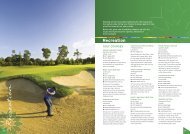

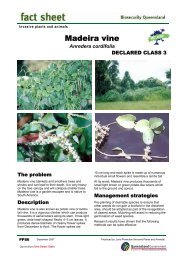


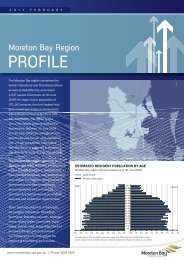
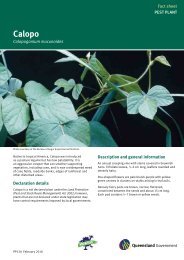

![Kumbartcho Brochure [PDF 540KB] - Moreton Bay Regional Council](https://img.yumpu.com/47220970/1/190x101/kumbartcho-brochure-pdf-540kb-moreton-bay-regional-council.jpg?quality=85)
